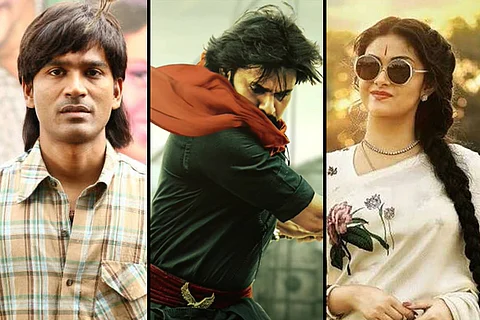

Several period films have come out in recent times, particularly in Telugu cinema, and there are many more which will be out soon. In such films set in the past, costumes play an important role in recreating the period. Be it Mahanati, which was a biopic, or the fantasy world of Baahubali, the costumes made a big impact on the viewer's mind, making them buy their favourite actors in the roles. Upcoming big budget period films include Prabhas's RadheShyam, Ram Charan and Jr NTR's RRR, Pawan Kalyan's Hari Hara Veera Mallu, and Nani's Shyam Singha Roy among others. The first look posters and teasers of the actors from these films have already built up expectations among viewers about the period and culture in which these films are set.
To give the look and feel of a period to the audience, it is the costume designers who play a pivotal role in the process. The costumes we see on the screen are a result of a lot of research, field work and a pinch of creativity. A team headed by the costume designer does the research on the particular period. If the entire film is set in that period, the research is quite extensive as the team has to be accurate and include authentic details to recreate the look.
Aishwarya Rajeev, costume designer for Kanche, Goutamiputra Satakarni, NTR Kathanayakudu, NTR Mahanayakudu, and the upcoming Pawan Kalyan film Hari Hara Veera Mallu among others, says that she has her own team to do costume research.
“We do research, we take references from existing information about that particular century while designing costumes. But it's not always easy to get information, as many times, it is not available,” says Aishwarya. “While doing Balakrishna's Gautamiputra Satakarni, the story was based on the 5th century and we did not have exact details or the records of costumes that were used in that period. So, in those circumstances, we need to take a call on what suits the era and finalise the color palettes and designs. We found that it was ornaments that were used more in that period than fabric, so we had to design the look like that, balancing the jewelry and the fabric.”
Spilling the beans about her next film with Pawan Kalyan, Aishwarya says that 40% of the shoot has been completed for the film, and that around 22 to 23 main costumes were used by Pawan Kalyan in the movie. The actor is playing Veera Mallu, an outlaw in the 17th century.
“For Hari Hara Veera Mallu, we mostly used handloom fabric, as we can dye them in natural colours. Depending on the availability of the material and the texture suitability, we went ahead,” adds Aishwarya. From Pawan Kayan's costumes to the junior artists, the entire look of the film was designed by Aishwarya and her team of 30 members. Aishwarya depends on Surat, Mumbai, and Hyderabad for her material sourcing.
If the period drama is based on real people, the kind of research and work involved is different. For example, the biopic of Savitri Devi, Mahanati. For this movie, which traces the life of the actor from the 1930s to the '80s, costume designer Gaurang Shah had to research and study what Savitri used to wear in those times.
Speaking to TNM, Gaurang Shah says, “It was a great experience working in the film. We did a lot of research after I was given the whole script, on what Savitri Devi used to wear, what looks they were given. Some scenes were recreated in the film, and we recreated the same costumes as the original with the same design and material. I have a network of weavers across India, and all these sarees in the film were woven by them. Each saree took anywhere between three to nine months,” says Gaurang.
He further explains, “We had to portray different stages in Savitri Devi's life, from a young girl to an elderly woman. We made different kinds of costumes for the characters, from pavadas and half-sarees to sarees. We put a lot of research into it. She used to love Banaras and Kanjivaram sarees with traditional colours, paired with high neck tight blouses. Later, she started wearing cotton sarees.”
But not all period dramas demand grand clothes that stand out. Some have to blend in. The Tamil film Vada Chennai is a realistic gangster drama set in the 1980s to the 2000s, and the brief given to costume designer Amritha Ram was that the clothes should not get noticed at all.
“I was told by director Vetrimaaran that we are talking about real people in real places, and that we should be true to that. We should not show them in a wrong or bad light. The clothes cannot look new. The director told me that if anybody said, ‘Oh my god, that particular costume looked amazing', then it stood out and we missed out on following the instructions. Fortunately, nobody said that,” says Amritha Ram.
Amritha adds that the costumes communicate the character’s personality to the audience. “What is visually told is what is grasped immediately. You wear a white coat, you become a doctor, you wear khakhi and you become the police. You relate to everything visually. It also helps the actors get into the skin of the characters,” she says.
For Vada Chennai, which was fortunately shot before the pandemic, Amritha made field visits to the places where the film was based, spoke to the local people, and went through their photo albums to get the look right. Amritha believes that clothes make a statement, and costumes tell a story as much as any other aspect of the film.